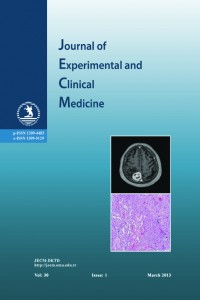Abstract
References
- Arias, L., Ruiz-Moreno, J., Gomez-Ulla, F., Fernandez, M., Montero J., 2009. 1-year retrospective review of ranibizumab for naive nonsubfoveal choroidal neovascularization secondary to age-related macular degeneration. Retina. 29, 1444-1449.
- Bhatnagar, P., Spaide, R.F., Takahashı, B.S., Peragallo, J.H., Freund, K.B., Klancnik, Jr.J.M., Cooney, M.J., Slakter, J.S., Sorenson, J.A., Yan- nuzzi, L.A., 2007. Ranibizumab for treatment of choroidal neovascularization secondary to age-related macular degeneration. Retina. 27, 846-850.
- Bird, A.C., Bressler, N.M., Bressler, S.B., Chisholm, I.H., Coscas, G., Davis, M.D., de Jong, P.T., Klaver, C.C., Klein, B.E., Klein, R., 1995. An international classification and grading system for age-related maculopathy and age-related macular degeneration. Surv. Ophthalmol. 39, 367-374.
- Ferris, F.L., Fine, S.L., Hyman, L., 1984. Age-related macular degeneration and blindness due to neovascular maculopathy. Arch. Ophthalmol- Chic. 102, 1640-1642.
- Gardner, T.W., Antonetti, D.A., Barber, A.J., LaNoue, K.F., Levison, S.W., 2002. Diabetic retinopathy: More than meets the eye. Surv. Ophthal- mol. 47, 252-253.
- Parravano, M., Francesco, O., Tedeschı, M., Chıaravallotı, A., Perıllo, L., Boccassını, B., Varano, M., 2010. Retinal functional changes measured by microperimetry in neovascular age-related macular degeneration treated with ranibizumab. Retina. 30, 1017-1024.
- Shin, H.J., Chung, H., Kım, H.C., 2011. Association between foveal microstructure and visual outcome in age-related macular degeneration. Retina. 31, 1627-1636.
- Squirrell, D.M., Mawer, N.P., Mody, C.H., Brand, C.S., 2010. Visual outcome after intravitreal ranibizumab for wet age-related macular degen- eration. Retina. 30, 436-442.
- Vujosevic, S., Midena, E., Pilotto, E., Radin, P.P., Chiesa, L., Cavar-zeran, F., 2006. Diabetic macular edema: Correlation between micro perim- etry and optical coherence tomography findings. Invest Ophth. Vis. Sci. 47, 3044-3051.
The effect of intravitreal ranibizumab injection on visual acuity and central macular thickness in subgroups with neovascular age-related macular degeneration
Abstract
In this study, we assessed the effect of at least three intraocular ranibizumab injections, which were performed for the treatment of subfoveal choroidal neovascularization (CNV) secondary to neovascular age related macular degeneration (AMD), on best corrected visual acuity (VA) and central macular thickness (CMT) in 89 patients who were classified by the component of lesion. Flouroscein angiography was performed and CNV have been classified in classic, occult or mixt (classic+occult) type. Best corrected VA was measured by Snellen card and was recorded in logMAR-logarithm of the minimum angle of resolution values. CMT was measured by optical coherence tomography. While CMT decreased significantly in patients with classic, mixt or occult type lesion (p=0.000; 0.011; 0.004, respectively), the increase in VA was detected only in patients with classic type lesion (p=0.001). A positive significant correlation between the decrease in CMT and the decrease in VA (logMAR) was reported only in the patients with occult type lesion (p=0.03). In conclusion, the anatomical improvement, that is seen as a result of the treatment of AMD with intravitreal ranibizumab injection, is not associated with the increase in visual acuity in all types of CNV.
Keywords
Age related macular degeneration Central macular thickness Choroidal neovascularization Ranibizumab Visual acuity
References
- Arias, L., Ruiz-Moreno, J., Gomez-Ulla, F., Fernandez, M., Montero J., 2009. 1-year retrospective review of ranibizumab for naive nonsubfoveal choroidal neovascularization secondary to age-related macular degeneration. Retina. 29, 1444-1449.
- Bhatnagar, P., Spaide, R.F., Takahashı, B.S., Peragallo, J.H., Freund, K.B., Klancnik, Jr.J.M., Cooney, M.J., Slakter, J.S., Sorenson, J.A., Yan- nuzzi, L.A., 2007. Ranibizumab for treatment of choroidal neovascularization secondary to age-related macular degeneration. Retina. 27, 846-850.
- Bird, A.C., Bressler, N.M., Bressler, S.B., Chisholm, I.H., Coscas, G., Davis, M.D., de Jong, P.T., Klaver, C.C., Klein, B.E., Klein, R., 1995. An international classification and grading system for age-related maculopathy and age-related macular degeneration. Surv. Ophthalmol. 39, 367-374.
- Ferris, F.L., Fine, S.L., Hyman, L., 1984. Age-related macular degeneration and blindness due to neovascular maculopathy. Arch. Ophthalmol- Chic. 102, 1640-1642.
- Gardner, T.W., Antonetti, D.A., Barber, A.J., LaNoue, K.F., Levison, S.W., 2002. Diabetic retinopathy: More than meets the eye. Surv. Ophthal- mol. 47, 252-253.
- Parravano, M., Francesco, O., Tedeschı, M., Chıaravallotı, A., Perıllo, L., Boccassını, B., Varano, M., 2010. Retinal functional changes measured by microperimetry in neovascular age-related macular degeneration treated with ranibizumab. Retina. 30, 1017-1024.
- Shin, H.J., Chung, H., Kım, H.C., 2011. Association between foveal microstructure and visual outcome in age-related macular degeneration. Retina. 31, 1627-1636.
- Squirrell, D.M., Mawer, N.P., Mody, C.H., Brand, C.S., 2010. Visual outcome after intravitreal ranibizumab for wet age-related macular degen- eration. Retina. 30, 436-442.
- Vujosevic, S., Midena, E., Pilotto, E., Radin, P.P., Chiesa, L., Cavar-zeran, F., 2006. Diabetic macular edema: Correlation between micro perim- etry and optical coherence tomography findings. Invest Ophth. Vis. Sci. 47, 3044-3051.
Details
| Primary Language | English |
|---|---|
| Subjects | Health Care Administration |
| Journal Section | Surgery Medical Sciences |
| Authors | |
| Publication Date | March 26, 2013 |
| Submission Date | August 29, 2012 |
| Published in Issue | Year 2013 Volume: 30 Issue: 1 |
Cite

This work is licensed under a Creative Commons Attribution-NonCommercial 4.0 International License.

